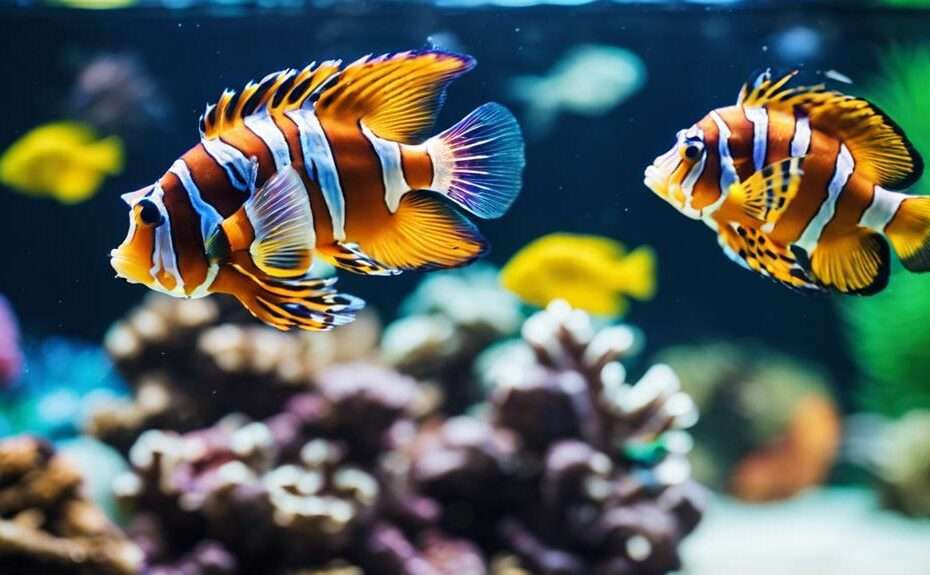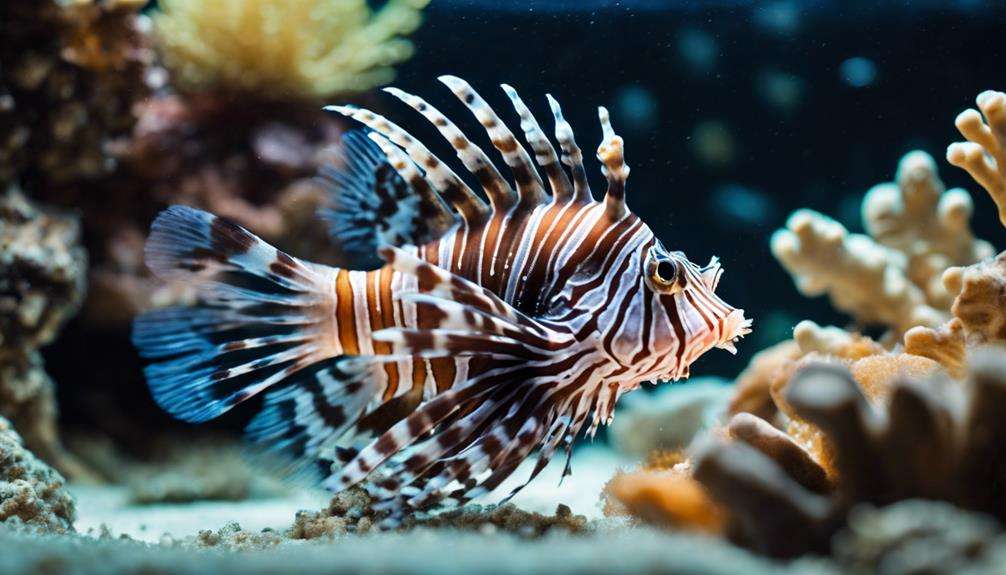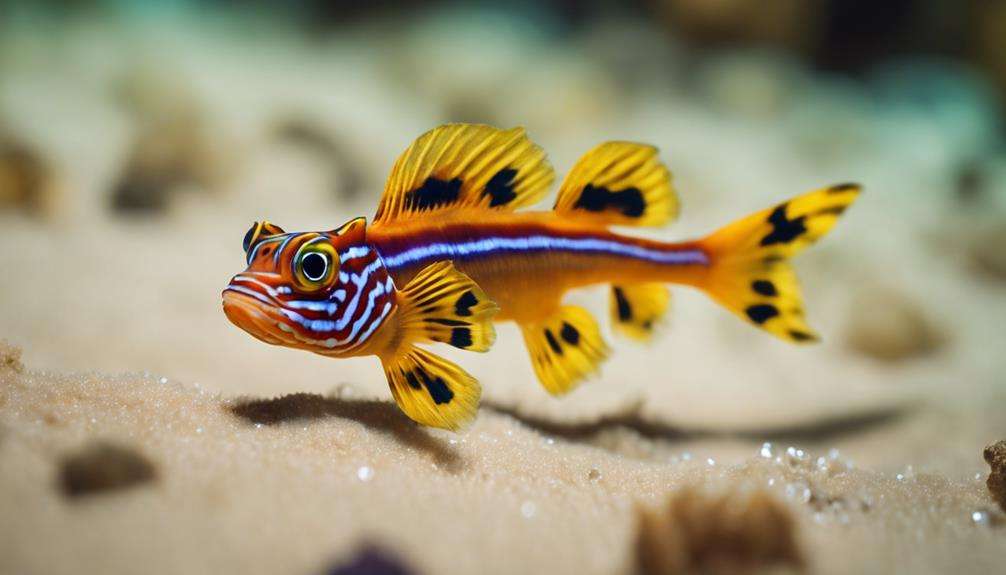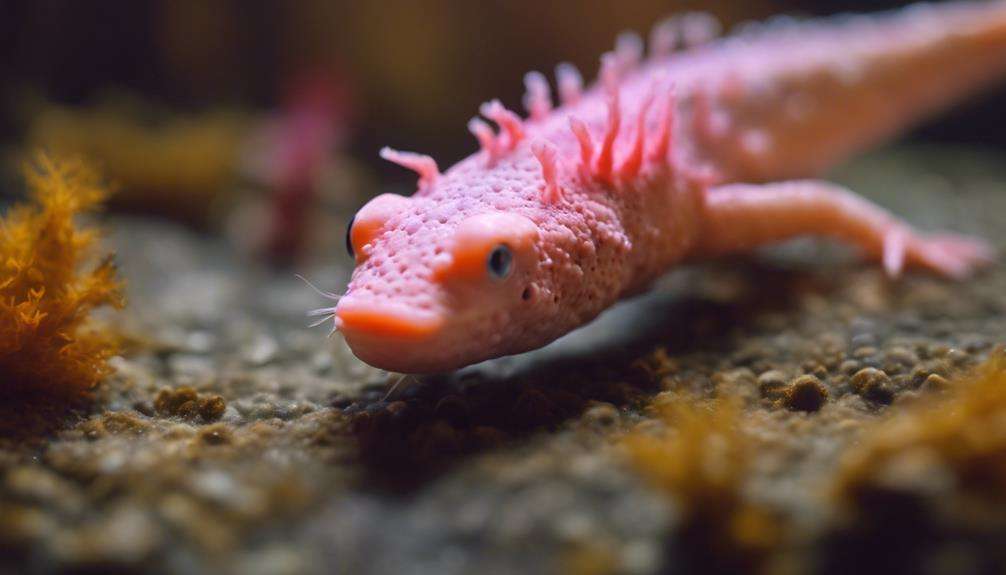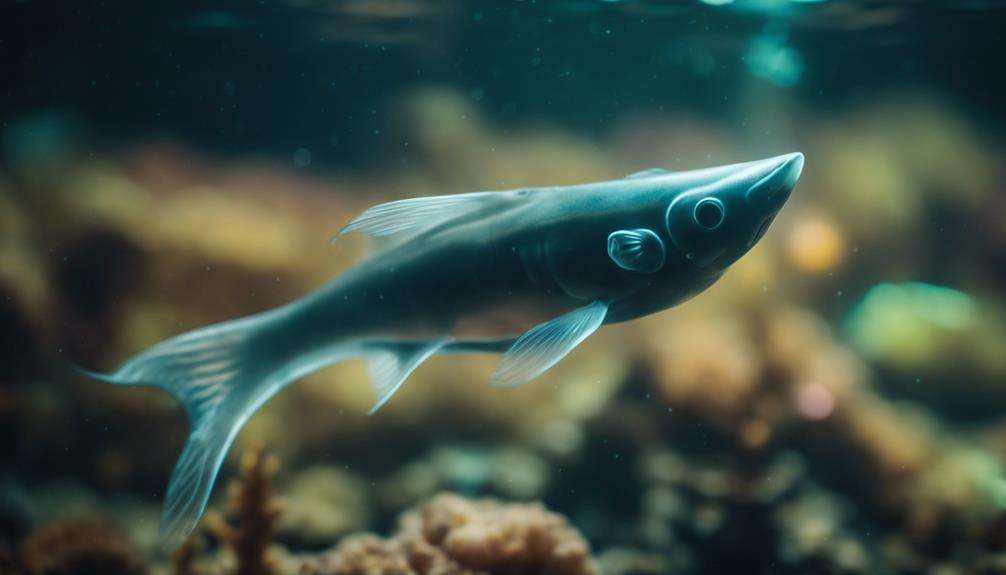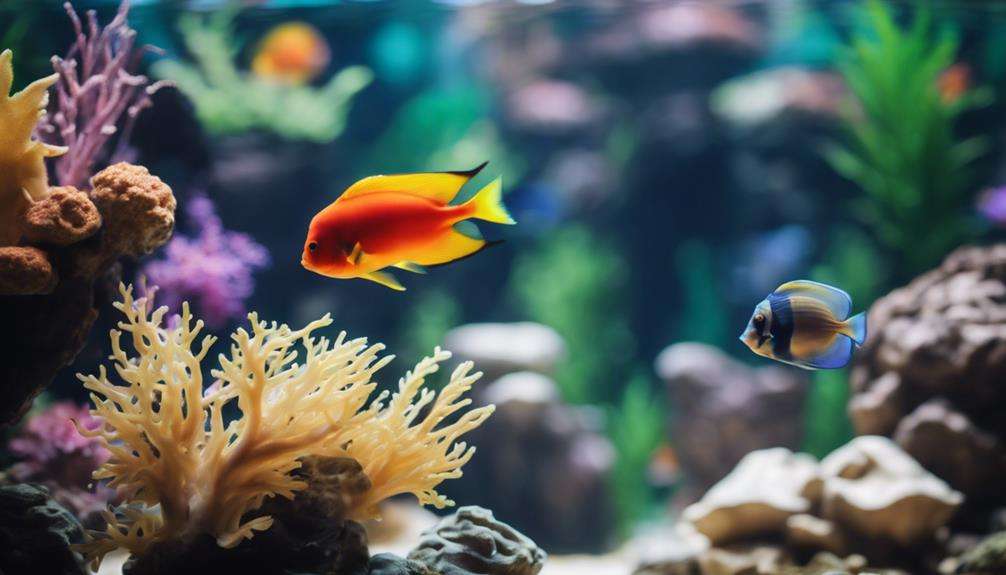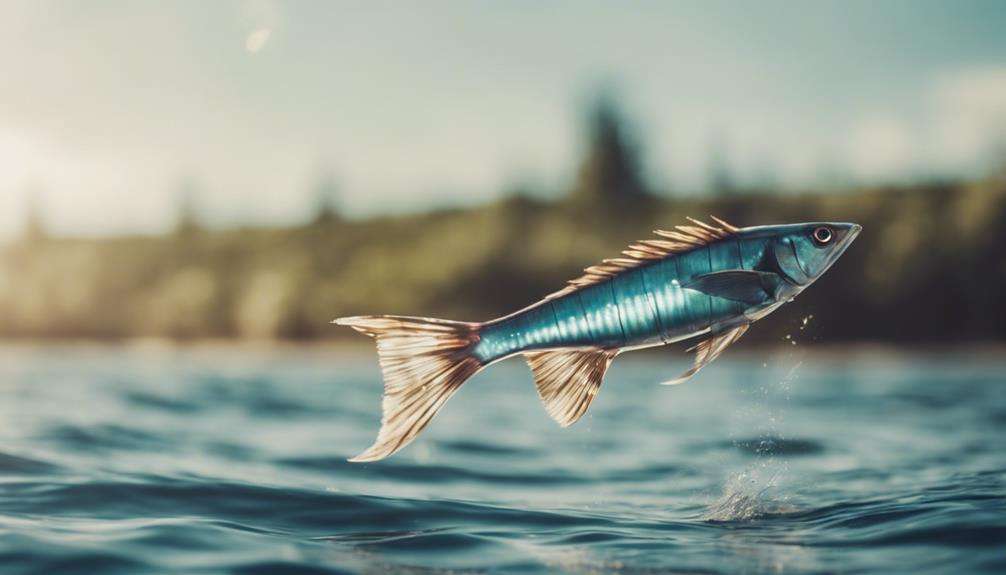Have you ever wondered if lionfish really do have compatible tank mates?
While it's a common belief that these mesmerizing predators should be kept alone due to their aggressive nature, there might be surprising companions that could thrive alongside them.
Exploring the intricacies of pairing lionfish with other species can lead to a fascinating journey of discovery and potential harmony in your aquarium.
So, which aquatic creatures could complement the majestic presence of a lionfish, creating a balanced ecosystem that captures the essence of the ocean?
Key Takeaways
- Choose tank mates like Rock Beauty Angelfish for a 100-gallon tank.
- Consider peaceful Threadfin Butterflyfish for a 75-gallon tank.
- Opt for Blue Tang in a 125-gallon tank with herbivorous companions.
- Pair Lionfish with Harlequin Tuskfish in a 125-gallon tank for a balanced mix.
Rock Beauty Angelfish
When considering tank mates for your lionfish, the Rock Beauty Angelfish stands out as a vibrant and striking option that requires specific care due to its semi-aggressive nature and territorial tendencies. These large fish, reaching sizes of 8-10 inches, are omnivores, feeding on algae, sponges, and small invertebrates. To accommodate their size and activity level, a tank of at least 100 gallons is recommended to provide ample space for both the angelfish and the lionfish.
Due to their territorial behavior, it's crucial to introduce the Rock Beauty Angelfish to the tank before adding the lionfish. This allows the angelfish to establish its territory and reduces the likelihood of aggressive interactions. Creating multiple hiding spots and visual barriers within the tank can also help mitigate territorial disputes between these species.
While the Rock Beauty Angelfish adds a splash of color and activity to your tank, it's essential to monitor their interactions closely to ensure a harmonious cohabitation with your lionfish.
Threadfin Butterflyfish
Threadfin Butterflyfish, also known as Chaetodon aurgia, are herbivorous marine fish commonly sought after for their peaceful temperament and vibrant appearance in saltwater aquariums. These beautiful fish can make excellent tank mates for lionfish due to their peaceful nature and dietary preferences.
Here are some key points to consider when thinking about adding Threadfin Butterflyfish to your tank:
- Herbivores: Threadfin Butterflyfish are herbivores, meaning they require a diet rich in plant-based foods to thrive in captivity.
- Peaceful: These fish have a peaceful temperament, which can help maintain harmony in a mixed species tank, reducing the likelihood of aggression.
- Tank Size: A minimum tank size of 75 gallons (283 liters) is recommended to provide enough space for Threadfin Butterflyfish to swim and explore comfortably.
With their stunning appearance, peaceful demeanor, and easy care level, Threadfin Butterflyfish can be a great addition to a saltwater aquarium, complementing the beauty of lionfish while contributing to a well-balanced aquatic environment.
Blue Tang
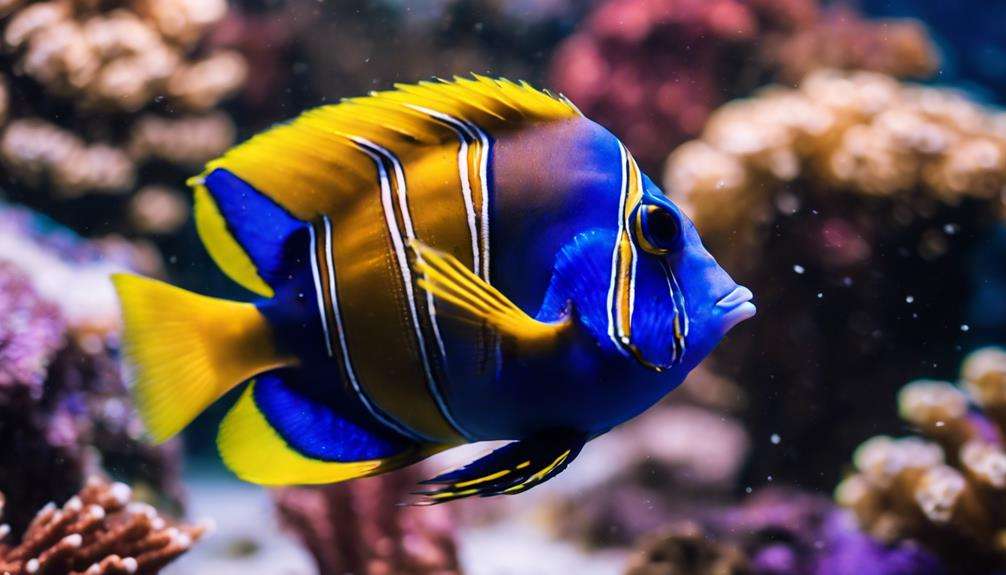
Blue Tangs, also known as regal tangs, are popular herbivorous fish often sought after for their striking blue coloration and unique appearance in saltwater aquariums. These vibrant fish are commonly found in coral reefs and can grow up to 9-10 inches, requiring a minimum tank size of 125 gallons to thrive. Blue Tangs exhibit a semi-aggressive and skittish behavior, emphasizing the need for a peaceful tank environment with ample hiding spots and open swimming space. Their care level is considered medium, and to maintain their health, a diet rich in algae and seaweed is essential.
When considering tank mates for your Blue Tang, it's crucial to select fish that can coexist peacefully with its temperament. Avoid aggressive or territorial species that might stress out the Blue Tang. Compatible tank mates may include peaceful fish like Clownfish, Gobies, and Dartfish. Additionally, ensure all tank mates share similar water parameter requirements to promote a harmonious aquatic environment for your Blue Tang and its companions.
Maroon Clownfish
With their striking deep red coloration and unique personality, Maroon Clownfish (Premnas biaculeatus) are highly sought-after additions to saltwater aquariums. Maroon Clownfish are compatible tank mates for lionfish due to their peaceful nature, making them an excellent choice for a mixed species tank.
Here are some key points to consider when adding Maroon Clownfish to your aquarium:
- Peaceful Nature: Maroon Clownfish have a peaceful demeanor, which helps in maintaining harmony within the tank environment.
- Territorial Behavior: Despite their peaceful nature, Maroon Clownfish can be territorial, especially when it comes to their anemone homes. Ensure they've adequate space to establish their territory.
- Symbiotic Relationship: Maroon Clownfish form strong bonds with anemones, creating a visually stunning and mutually beneficial relationship in the tank.
Harlequin Tuskfish
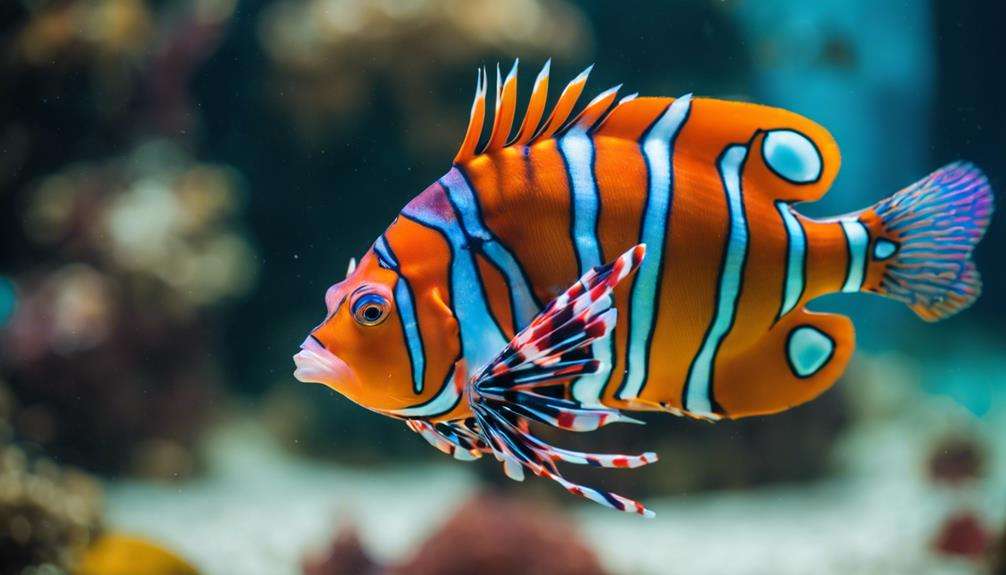
Harlequin Tuskfish, also known as Choerodon fasciatus, are carnivorous marine fish that can grow up to 10-12 inches in size. These striking fish have a semi-aggressive temperament and are best suited for a minimum tank size of 125 gallons. When considering tank mates for Harlequin Tuskfish, it's important to take into account their carnivorous nature. They thrive on a diet of meaty foods such as shrimp and fish. Due to their semi-aggressive tendencies, it's advisable to pair them with tank mates that can hold their own or aren't easily intimidated.
In terms of compatibility, Harlequin Tuskfish may not be the best choice for shy or passive tank mates. Their territorial behavior and penchant for meaty foods could lead to conflicts in the aquarium. However, with careful consideration and monitoring, they can coexist with other semi-aggressive species that share similar requirements. Overall, providing ample space, appropriate tank mates, and a varied diet are key to successfully keeping Harlequin Tuskfish in a marine aquarium.
Anglerfish
Anglerfish are fascinating creatures known for their unique appearance and predatory behavior. They possess a bioluminescent lure on their head to attract unsuspecting prey, showcasing their ambush predator tactics.
Understanding Anglerfish Characteristics, Behavior, and Care Requirements is crucial for successfully integrating them as tank mates for Lionfish.
Anglerfish Characteristics
Known for their bioluminescent lure on their heads, anglerfish are deep-sea predators that use this unique adaptation to attract prey in the dark depths of the ocean. These fascinating creatures possess sharp teeth and expandable stomachs, allowing them to consume prey much larger than themselves.
Anglerfish have also developed symbiotic relationships, where males fuse to females for reproduction, ensuring the survival of their species in the harsh ocean environment. Their ability to adapt to extreme conditions with limited food sources showcases their evolutionary prowess.
These characteristics make anglerfish intriguing additions to a tank environment, providing a glimpse into the complex and mysterious world of deep-sea fish.
- Anglerfish possess sharp teeth and expandable stomachs for consuming large prey.
- Some anglerfish species exhibit symbiotic relationships where males fuse to females for reproduction.
- Adapted to survive in extreme environments with limited food sources.
Anglerfish Behavior
With their mastery of camouflage and unique hunting method using a bioluminescent lure, anglerfish exhibit a fascinating array of behaviors that highlight their adeptness as ambush predators in the deep-sea environment.
These specialist sponge-feeders are aggressive when it comes to securing their next meal. Anglerfish rely on their cleverly disguised appearance to blend seamlessly into their surroundings, waiting patiently for unsuspecting prey to come within striking distance.
Their elongated bodies and large mouths are perfectly adapted for swallowing prey whole in one swift motion. Being primarily solitary creatures, anglerfish prefer to hunt alone, using stealth and cunning to catch their victims off guard.
These behaviors make them formidable ambush predators in the dark depths of the ocean.
Anglerfish Care Requirements
To properly care for anglerfish in an aquarium setting, ensure the tank size is a minimum of 50-60 gallons due to their size requirements. Here are some essential care requirements for anglerfish:
- Diet: Anglerfish are carnivorous and need a diet of live or frozen meaty foods to thrive.
- Hunting Technique: They're known for their unique hunting technique using a lure on their head to attract prey.
- Tank Mates: Anglerfish can be aggressive towards smaller tank mates, so it's crucial to choose companions carefully, especially when considering large or small fish like potential Lionfish tank mates.
Panther Grouper
Panther Groupers, known for their impressive size potential of up to 27 inches, require a substantial tank size of at least 300 gallons.
Due to their carnivorous nature and territorial behavior, caution is advised when selecting tank mates, especially smaller fish.
Understanding their compatibility, behavior, and tank size requirements is crucial for maintaining a harmonious aquatic environment.
Compatibility With Panther Grouper
Consider housing a Panther Grouper with similarly sized or larger fish to prevent aggression issues in your tank. Panther Groupers are aggressive and territorial by nature, requiring careful consideration when selecting tank mates. Here are some key points to keep in mind regarding their compatibility:
- Size Discrepancy: Panther Groupers can view smaller fish as potential prey due to their predatory instincts, so it's crucial to choose companions of comparable size or larger.
- Aggression Management: To minimize conflicts, provide ample hiding spots and territories within the tank to help distribute aggression and reduce territorial disputes.
- Monitoring Behavior: Regularly observe interactions between the Panther Grouper and other tank inhabitants to ensure harmony and address any signs of aggression promptly.
Behavior and Interaction
For optimal understanding of Panther Grouper behavior and interaction, it's essential to observe their predatory instincts and territorial tendencies in an aquarium setting. Panther Groupers, being carnivorous saltwater fish, exhibit aggressive territorial behavior that can pose challenges when kept with other species like Lionfish.
Their predatory nature and large size potential of up to 27 inches make them formidable tank mates, especially for smaller fish. Competition for food sources in the tank can arise due to their carnivorous diet, potentially leading to conflicts with Lionfish. Their territorial behavior may result in aggression towards other tank mates, causing stress and disrupting the harmony within the aquarium.
Considering these factors, it's advisable to carefully evaluate the compatibility of Panther Groupers with Lionfish before introducing them in a shared tank environment.
Tank Size Requirements
To ensure optimal habitat conditions for Panther Groupers, a minimum tank size of 300 gallons is imperative due to their substantial growth potential and territorial nature. Panther Groupers require ample space to swim freely and establish territories within the tank. Here's why the tank size is crucial for Panther Groupers:
- Panther Groupers can grow up to 27 inches in length, necessitating a spacious environment.
- A larger tank size helps minimize aggression and territorial disputes among tank mates.
- Providing a large tank for Panther Groupers promotes their well-being and natural behaviors in captivity.
Ensuring the appropriate tank size not only benefits the Panther Grouper but also contributes to a harmonious tank environment for all inhabitants.
Clown Triggerfish
With its vibrant coloration and territorial behavior, the Clown Triggerfish (Balistoides conspicillum) is a carnivorous fish that demands careful consideration when choosing tank mates. These striking fish can grow up to 20 inches and require a tank of at least 120 gallons to thrive. Clown Triggerfish are known to be solitary and aggressive towards other tank mates, especially smaller or similarly sized fish.
Their carnivorous diet includes meaty foods like shrimp, squid, and fish, often necessitating a varied diet for optimal health. To successfully keep Clown Triggerfish with other species, it's crucial to provide hiding spots and ample space to reduce aggression in a mixed tank environment. Due to their territorial nature, compatible tank mates for Clown Triggerfish should be chosen wisely to prevent conflicts and ensure the well-being of all inhabitants.
When considering tank mates for Lionfish, it's essential to understand the Clown Triggerfish's behavior and dietary requirements to create a harmonious aquatic environment.
Frequently Asked Questions
Can You Keep 2 Lionfish Together?
You shouldn't keep 2 lionfish together due to their aggressive and territorial behavior. They need their own space to avoid stress, injuries, and potential harm. Each lionfish should have its tank, which is essential for their feeding habits and well-being.
Do Lionfish Eat Clownfish?
Yes, lionfish do eat clownfish. Due to their carnivorous nature, lionfish view clownfish as prey. Clownfish compatibility is not recommended due to the risk of predation. Consider the feeding habits and tank size when housing them together.
Can Clownfish and Lionfish Live Together?
Yes, clownfish and lionfish can live together in a well-equipped tank. Clownfish behavior and tank setup are crucial for their compatibility. Monitor their feeding habits and interactions for a successful cohabitation. It's an interesting dynamic to observe.
Can Lionfish Live With Puffer Fish?
You must consider puffer fish compatibility cautiously. Their territorial nature and different dietary needs may lead to conflict in the tank. Be mindful of tank size for space and observe feeding habits for potential issues.
Conclusion
Congratulations on choosing the best tank mates for your lionfish!
With the addition of Rock Beauty Angelfish, Threadfin Butterflyfish, Blue Tang, Maroon Clownfish, Harlequin Tuskfish, Anglerfish, Panther Grouper, and Clown Triggerfish, your aquarium will be a vibrant underwater paradise filled with unique and fascinating marine life.
Your lionfish will thrive in this diverse community, creating a harmonious environment that showcases the beauty of the ocean right in your own home.
Happy fishkeeping!
